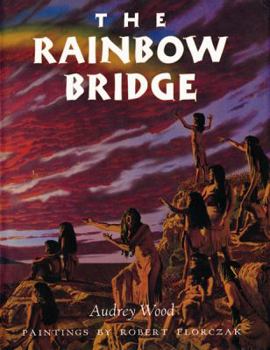The Rainbow Bridge
Select Format
Select Condition 
Book Overview
Hutash the earth goddess creates a rainbow bridge--and saves her people from drowning by turning them into dolphins. This description may be from another edition of this product.
Format:Hardcover
Language:English
ISBN:0152654755
ISBN13:9780152654757
Release Date:January 1995
Publisher:Harcourt Brace and Company
Length:32 Pages
Weight:1.15 lbs.
Dimensions:0.4" x 9.3" x 12.2"
Age Range:6 to 9 years
Grade Range:Grades 1 to 4
Customer Reviews
2 ratings
A Chumash legend regarding creation and much more
Published by Thriftbooks.com User , 18 years ago
"The Rainbow Bridge," retold by Audrey Wood with oil on canvas paintings by Robert Florczak, is inspired by a Chumash tale. The name of that Native American tribe will be familiar to young readers who watched "Buffy the Vampire Slayer," since several members of the Chumash tribe showed up one memorable Thanksgiving in Season 4 (and did things to Xander that cannot be discussed in polite company). The Chumash lived in what is now the central California coast from Los Angeles northward to San Luis Obispo. There were a peaceful people, known for their art, mainly basketry and cave paintings, and their distinctive social and spiritual culture. The Storyteller's Note at the start of this oversize book explains that the most famous invention of the Chumash was the "tomol," a plant canoe, that allowed them to trade with villagers on nearby islands. They were rather unique as a native people because they could find everything they needed in the environment in which they lived, without having to raise crops or domesticate animals. This story was inspired by an oral Chumash legend, expanded by Wood in terms of both characters and lengths. It begins with Hutash, the earth goddess, walking alone on the island of Limuw. Gathering seeds from a sacred plant she scatters them upon the earth so that there might be people, teh Chumash tribe, made in her own image. Along with her husband, the great wise Sky Snake (a.k.a., the Milky Way), Hutash loved the people and gave them gifts so that they would thrive. But then there were too many people and Hutash told the people that Limuw had grown crowded and in three days half of them must leave and go to the land across the water while the other half stay on her island. The rainbow bridge stretching from the highest mountain on Limuw to the highest mountain on the land across the water is how the people who left Limuw would travel to their new home. The problem is that some of the Chumash look down during their journey and fall from the great height in to the ocean, where Hutash must act to save them. The story of "The Rainbow Bridge" is part-creation story, which makes for parallels to Genesis and other creation stories, but there are obvious comparisons to be made to other sacred stories and legends in class discussion. Some additional research might be involved, but should be well worth the effort and class time spent on exploring issues of comparative mythology. A portion of the royalties from the sale of "The Rainbow Bridge" will be donated by the author for the further preservation and undersanding of the Chumash culture. The author even recommends "The Chumash People: Materials for Teachers and Students" from the Santa Barbara Museum of Natural History as an excellent source of additional information you children.
Legendary
Published by Thriftbooks.com User , 24 years ago
If you like folklore and legends you will love this book. I found it fascinating especially when the people who fell from the bridge turned into dolphins. The illustrations were beautiful and some were almost life like.






